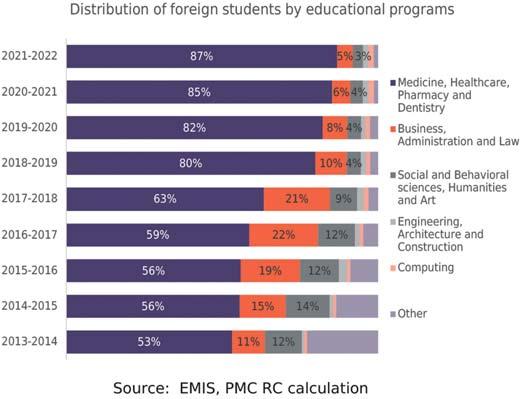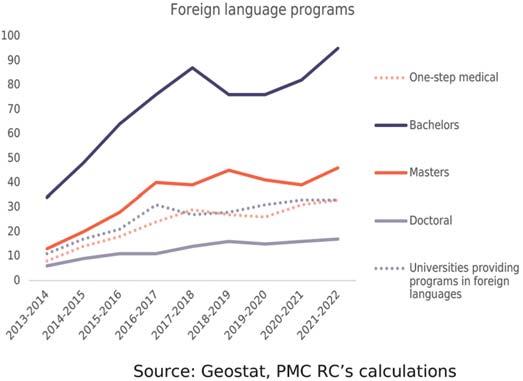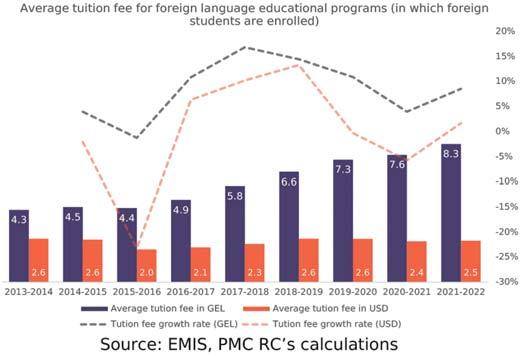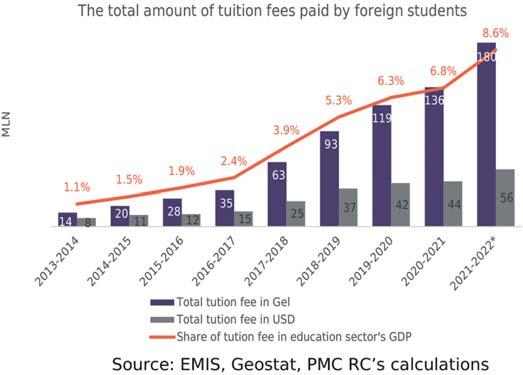
25 minute read
POLITICS
from Issue #1337
The Real and Present War
OP-ED BY NUGZAR B. RUHADZE
Advertisement
Ithought the war wouldn’t happen, but it did. I presumed the Russians would act more wisely, but they didn’t. Is this my naiveté or lack of political judgment? Both! War is stupid and horrible, but people still go to it. And there is one happening right now in the middle of Europe.
After a prolonged mess near the Ukrainian border, the Russian troops invaded Ukraine. The incursion was widely expected at any given moment, but hopes of avoiding the war didn’t die until the very instance of intrusion. Then the war became very real and very present. The Russian army and its war gear are currently on an assault from north, east and south on Ukrainian territory, closing in on Kyiv to take it over and put Ukraine on its knees. Clashes between the attacking and defending forces have become ubiquitous, but the fi nal outcome of this roaring confl ict is still far from having yielded to the Russian-planned bottomline, which is the reinstatement of the Russian-Ukrainian centuries-old marriage so that they can never divorce again, the roost being ruled by Russia. Intensively reinforcing the Ukrainian army with military supplies and arms, the West is so far fi ghting the intruder only verbally, threatening Russia with harsh economic and fi nancial sanctions that might not have an immediate effect. The West seems to be trying to prevent the confl ict coming to a head, although the heavy inveighs and caustic vituperation against Russia are growing not by the hour but by the minute. and the Russian president is taking the entire verbal western assault in his stride.
The news all over the planet proclaims the desperate people of Ukraine wanting and ready to build up their self-defense in an attempt to save their only recently acquired national freedom, independence and democracy. The world supports the Ukrainian cause, Georgia among them, although our support has its own particular parameters and content, with the current Georgian government poised to provide moral and humanitarian assistance to our Ukrainian brothers and sisters while refraining from hailing the Western sanctions against Russia.
The situation in the invaded land is changing minute to minute, so much so that the content of this piece might become irrelevant to publish by the time it runs in the Paper. What the Ukrainian people need forthwith is real help from real fi ghters in a real battle against a real enemy. None of these are yet in place. Meanwhile, the Russian military juggernaut is approaching its long-cherished fi nal target, and procrastination of real-life assistance might mean the Ukrainians losing their country. The resistance is strong and intense, which will prolong the confl ict for longer than expected, yet this is exactly where the skeletons are buried and the shoe is pinching. Months prior to the beginning of the skirmish, Russia asked America and NATO to consider the most burning issues of its national security. The western opponents responded with an immediate categorical rejection of the request, instead of starting long-term thoughtful and patient negotiations on a variety of issues to balance out the Russian-Western compounded interaction, which might well have brought calm to both sides and an avoidance of this war.
The American president is defi nitely concerned with the crisis in Ukraine, but the solid set of strong and weak points in his administration that he will have to bring to the threshold of the next presidential elections in the States matter no less. The American people feel OK right now with unemployment going down and the salaries going up, the keeping up of the tolerable standard of living. But God forbid the situation in Ukraine has a negative effect on their good life. Then the Russian-Ukrainian issue might become more biting to the POTUS, who sees America doing fair and right right now. Russia has spent a lot of resources on the war and it has sacrifi ced its international reputation, having subjected itself to those crippling western sanctions, sending a very meaningful and incisive message to the Russian people about its current government. This means that Russia is more in the red than in the gain as a result of the whole deal. And this might be enough of a reason for Moscow not to give up on its military and political goal to have Ukraine back as an ally and disciple, easily manipulated in Russia’s best national interests and restoring its once forfeited sense of national security.
The American people feel OK right now with unemployment going down and the salaries going up, the keeping up of the tolerable standard of living. But God forbid the situation in Ukraine has a negative effect on their good life. Photo by Jerome Adamstein / Los Angeles Times
Prof. Sergey Radchenko on the War, the Repercussions, and What Lies ahead for Russia and Georgia

Continued from page 1 And we can see just how that has empowered the West in its policy of economic sanctions against Russia, because the moment the West fi nally came around to understanding the gravity of the Russian threat and acted in unison, we could see that the economic sanctions being applied have proven catastrophic for the Russian economy: the Russian stock market collapsed.
IS IT NOT IRONIC THAT PUTIN AND THE KREMLIN FOR DECADES HAVE BEEN USING ECONOMIC RESOURCES AS A LEVERAGE AGAINST THE WEST, AND NOW IT’S TURNED ON THEM?
Well, yes. And Russian leadership has to recognize that Russia is not really an economic superpower. And it is hugely exposed for various reasons. But Putin is not an economist. I don’t think he fully understands the economic implications of this, or if he understands them, he may understand them at some philosophical level, but he doesn’t see the practical implications, and the practical implication is that everybody in Moscow in a position of economic authority is now pulling their hair out, and whispering, “What is this? This is crazy, the Russian economy is being torn apart.” And this is dangerous, because this creates huge instability. And it means even less room for Putin to maneuver, and then he’ll see himself as being cornered. And I think that is where the situation becomes extremely dangerous.
YOU SAY PUTIN GAMBLED, AND FAILED. HOW COME?
I think Putin’s strategic genius has been vastly overstated. I’ve always been very skeptical of Putin’s strategic genius. He has made some interesting tactical moves, yes, but in strategic terms, Putin’s entire foreign policy, going back years and years, has been counterproductive and detrimental to Russia’s national interest. This is a position of someone who sees the future of Russia in Europe – and all of the things that Putin has done have gone against this, and they have undermined Russia; they have turned Russia into the bogeyman of Europe. And so the question then is – what’s so great about that? How’s that a great strategic goal to strive for? I think it’s been a disaster.
BEING CORNERED MAKES HIM EXTREMELY DANGEROUS, YOU SAY. WHAT SHOULD WE EXPECT FROM THIS CORNERED ANIMAL?
I don’t think we’ve seen Putin play all his cards yet. We know that the military operation has been quite brutal so far, but it’s certainly not as brutal as could have been with a full scale Russian assault – I think this is a fraction of what we could see if we have further escalation of this confl ict. It seems Putin is still hesitating, and he’s maybe looking for some kind of way out, and if he’s looking for a way out, then perhaps he should be offered some political alternatives for de-escalation, because the danger of further escalation is too great to ignore. We don’t know what’s going through his mind. But the key thing is to assume that he’s still a rational being, and that he’s not crazy, because if he’s crazy, we can’t do anything about it. If he’s a rational being, then we can at least infl uence him in the right direction.
HOW WORRIED SHOULD THE WEST BE RE: THE NUCLEAR THREAT FROM RUSSIA?
Russia doesn’t have a system like the United States with DEF CON. The United States has DEF CON 1,2,3,4, and 5, with DEFCON one actual nuclear war. Russia doesn’t have that. So when Putin says, you know, let’s make our nuclear forces ready, it’s unclear what he means by this. That seems more like just saber rattling in order to remind the West that it should be more accommodating and careful around Russia.
WHAT SHOULD THE WEST’S STRATEGY BE, CONSIDERING THIS MAJOR SHIFT IN ATTITUDE THAT WE HAVE SEEN IN THE LAST COUPLE OF DAYS?
Well, we should continue to look for diplomatic solutions. Always. We are not in a situation like in 1945, where he is Hitler or Hirohito and we should be calling for unconditional capitulation or else. I think, obviously, Putin has cornered himself, unleashed a military campaign, and Russia is going to pay the price, there’s no doubt that it’s already paying the price. But fundamentally, diplomatic solutions should remain on the table. We should be talking about incentives, like lowering some sanctions if he stops military action, and this is going to be a diffi cult sell in many Western countries, because it was extremely diffi cult to get Western unity on Russia in the fi rst place. Nevertheless, I think it’s the responsible thing to do. HOW MANY ALLIES DOES PUTIN HAVE LEFT AND HOW LONG ARE THEY PREPARED TO STICK WITH HIM?
Russia has not got many allies. Obviously, it has its clients in Central Asia. Belarus is an ally for sure. But how useful are those allies? Belarus has certainly proven to be very useful – it’s an alliance of dictators. China is not a formal ally. So the big question is whether China will break ranks with Russia, and China has been sitting on the fence, they have been trying to support Russia a little bit in some ways, through a kind of benevolent neutrality. But they certainly haven’t been as obliging to Russia as Putin might have expected, given the close relationship between him and Xi Jinping. The Chinese have their own interests, they’re looking after their own interests, and those interests are not going to be the same as Russia’s.
LET ME ALSO ASK YOU ABOUT THE PROVERBIAL “OTHER RUSSIA.” WHERE ARE THEY? A HANDFUL OF PEOPLE OUT OF A COUNTRY OF 142 MILLION?
I don’t think the majority of the Russian people want this war. There is the liberal intelligentsia – all of them are opposed to Putin to one extent or another – from the viciously opposed like myself to moderate opposition. There’s also a large number of people in Russia who see the whole war as a very unfortunate undertaking. There’s also a minority of Russians, a very sizable minority, maybe even half of Russians, that, unfortunately, will support this this confl ict until bitter and. I think the Russian people will have to come to terms with the fact that Russia is waging an aggressive war, and there’s just no way around that, and a reckoning will come.
COMING TO TERMS ALSO MEANS SPEAKING OUT ABOUT IT? TAKING ACTION?
In the short term, yes. We can expect more in the long term. We should expect some kind of realization that Russia is not benign, as a lot of Russians still think that Russia is a benign actor. It’s not, you know, it’s waging aggressive war.
HOW IS IT GOING TO CHANGE THE PUTIN PERCEPTION IN RUSSIA, THIS IMAGE OF THE ENLIGHTENED DESPOT OR AUTOCRAT?
Well, that is diffi cult to say, because Putin’s approval rating has been consistently high. There is a possibility, if this war continues, that his approval rating will decrease. In terms of how history will remember Putin, I think he is badly miscalculating if he thinks that history will remember him as the gatherer of lands. History will remember him as the man who clung to power, who became increasingly autocratic and missed every opportunity to integrate Russia with Europe. And that’s a huge failure today. It’s a crime.
AND FINALLY, WHAT’S AT STAKE FOR GEORGIA HERE?
Putin sees Ukraine as part of the Russian historical space, and Georgia – less so. Georgia and its culture are strange, alien things to him. But undoubtedly, if Putin is successful in Ukraine and infl icts heavy damage on Ukraine, then it will be a signal to Georgia not to go too far in its aspirations to join NATO. And also a signal to the West that it shouldn’t invite Georgia further into the alliance.
THE ISET ECONOMIST
A BLOG ABOUT ECONOMICS AND THE SOUTH CAUCAUS www.iset-pi.ge/blog
The ISET Policy Institute (ISET-PI, www.iset-pi.ge) is an independent think-tank associated with the International School of Economics at TSU (ISET). Our blog carries economic analysis of current events and policies in Georgia and the South Caucasus region ranging from agriculture, to economic growth, energy, labor markets and the nexus of economics, culture and religion. Thought-provoking and fun to read, our blog posts are written by international faculty teaching at ISET and recent graduates representing the new generation of Georgian, Azerbaijani and Armenian economists.
Top 5 Economic Consequences of Russia’s War on Ukraine: a View from Georgia
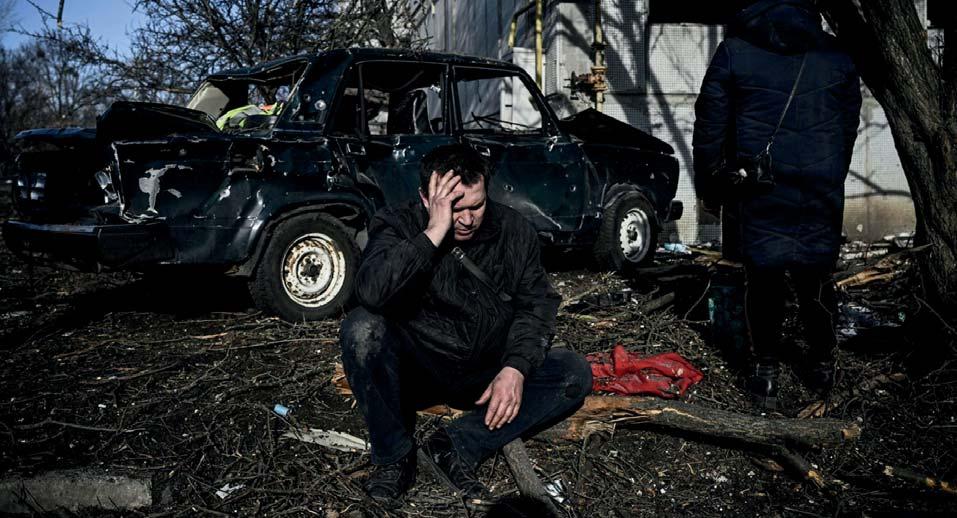
An apartment complex in the eastern Ukraine town of Chuguiv was hit in an airstrike on Feb. 24. Photo by Aris Messinis/AFP/Getty Images
BY YASYA BABYCH FOR ISET
As I am writing these lines, Russian tanks are moving deeper into the territory of my country, Ukraine, and emotions are threatening to overwhelm me. But emotions cannot shake what we, as economics scholars, value most: devotion to truth, and careful, impartial use of facts and logic to arrive at conclusions.
In this spirit, what can we say about the top 5 economic threats arising from the war that Russia is waging in Ukraine, especially from the standpoint of a small but strategically and historically important regional player – Georgia?
The fi rst economic casualty will be prices, in particular prices of fuel and food staples: wheat, corn, cooking oil. FOOD STAPLES
Both Russia and Ukraine are important global exporters of basic agricultural commodities. According to data from 2020, Russia and Ukraine combined accounted for 26% of global wheat exports, with Ukraine responsible for 8% (not surprisingly, Chicago wheat futures rose sharply as the invasion of Ukraine began). Both countries account for 24% of global barley exports; 57% of the world’s exports of sunfl ower seed, saffl ower, and cottonseed oil. Ukraine alone accounts for 13% of the world’s corn exports. Most of Ukraine’s wheat goes to Asia or Africa, putting food security in these regions immediately at risk, but also implying steep price rises in the rest of the world.
OIL AND GAS
Since the start of the war on February 24th, the Brent Crude oil prices have jumped to their highest level since 2014. In recent days, the price went over $100 per barrel. Just to compare, at the beginning of 2022, the price hovered around $80 per barrel. This spike is driven, on the one hand, by a large gap between global demand and supply caused by the pandemic, and, on the other, by the geopolitical threat, given that Russia is the third-largest oil producer in the world. Russia currently supplies one-tenth of world oil consumption, and close to half of Europe’s gas.
IMPLICATIONS FOR GEORGIA
One has to keep in mind that even before the war started, global food prices were rising rapidly due to the Covid-19 pandemic and the strain it put on global production and supply chains (FAO reported a 28% food price increase in 2021). But the situation will be exacerbated by the war. Since Georgia depends on imports of wheat for more than 90% of its consumption (much of the import comes from Russia), the global price increase will have an immediate effect on the country, in particular on the livelihoods of the poor. The rise in the price of fuel is already being felt in Georgia. For the government, it means that they must start planning on how to soften the blow for its poor and most vulnerable groups. Very likely these measures would imply more foreign borrowing, which brings us to the second set of risks.

FINANCIAL MARKETS FACE UNCERTAINTY. ECONOMIC RECOVERY FROM COVID UNDER THREAT
Financial markets are not yet prepared to price in the risks that may be coming from this war. Morgan-Stanley investment chief warned that any short-term trading on the confl ict is likely to “get it wrong”. This means that fi nancial markets could still experience wild swings going forward, which will increase the cost of borrowing and slow global growth. Bloomberg analytics also warns that growth will be slowed down as households spend an increasing share of their income on food and fuel, thus leaving fewer resources for other purchases.
For Georgia, increased uncertainty on the global fi nancial markets could also imply higher borrowing costs. However, one has to keep in mind that Georgia’s sovereign debt is mostly a low-interest multilateral debt to international organizations. This means Georgia may not be immediately and severely hit by the rising cost of borrowing on the international markets. However, Georgia’s investment and FDI may be impacted, as uncertainty about the geopolitical situation in the region grows. However, if the value of the Georgian Lari deteriorates, as a result, one may expect the country’s debt to GDP ratio to rise even further. top fi ve export destinations for Georgia. Ukraine accounted for 9.5% of Georgia’s exports in January 2022, while Russia for 12.9%. The biggest linkages, however, come not from the export of goods but from services, such as tourism. If the situation deteriorates, tourism from both countries will suffer signifi cantly or might even stop.
As far as imports into Georgia, Russia accounts for about 11% of total imports (the second-largest share after Turkey), while Ukraine is in 7th place with 4.3%.
REFUGEE CRISIS
A refugee fl ow from Ukraine is likely to reach an unprecedented magnitude. EU countries already estimate that more than 7 million people will be displaced. In Georgia, there is tremendous public support and readiness to take in refugees from Ukraine. However, as the fi ghting rages in the North, East, and South of Ukraine, there is currently almost no physical possibility to get to Georgia by air, land, or sea. Most of the refugees are now on the western borders, taken in by Poland, Slovakia, Romania, Hungary.
ANTICIPATION OF WHAT MIGHT BE NEXT – GEORGIA’S PERSPECTIVE
Perhaps the most frightening consequence of this war is the anticipation of what (or who) might be next, especially if the most pessimistic scenarios are allowed to unfold. It is very doubtful that Georgia will be spared in the imperialistic game, even if behaves “cautiously” – i.e., does not join global sanctions against Russia, avoids infl ammatory rhetoric, etc. Other countries realize Georgia’s predicament, and if worse comes to worst, international investments and FDI are likely to dry up.
Finally, there is the question which economics alone cannot answer: is the world (including Georgia) prepared to pay the price that this war will impose? Will the world continue supporting Ukraine’s struggle for independence, or is it more likely to favor peace at any cost with Russia? The phrase I often hear from Georgians and Ukrainians alike is that if you surrender your freedom for bread today, tomorrow you will have no bread and no freedom.
Based on the events of the recent days, it seems to me that the Georgian and Ukrainian people are choosing their current and future freedom. I only hope that the rest of the world will have the strength to follow their example.
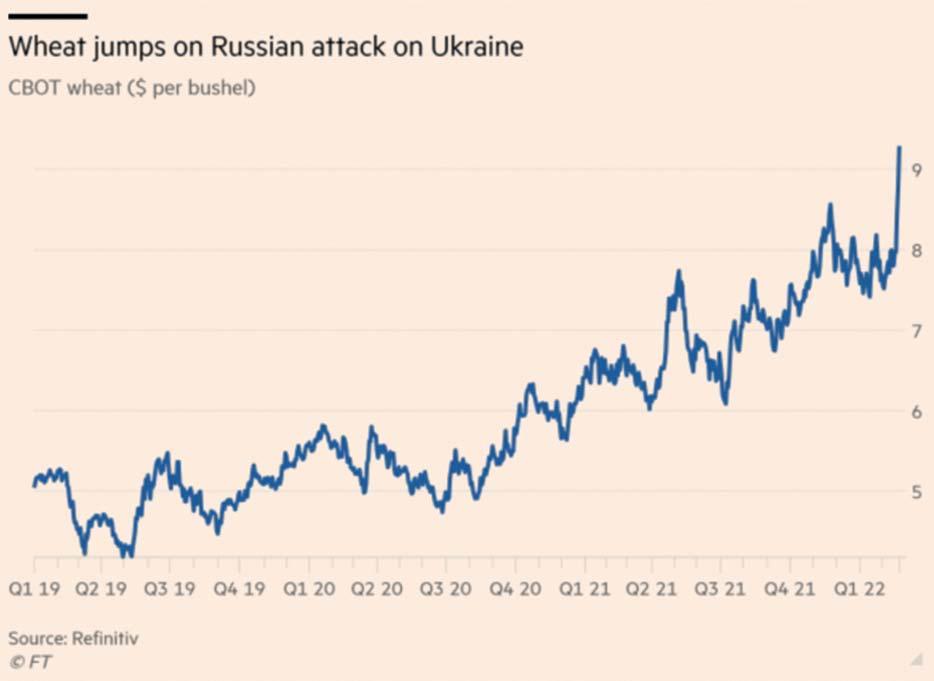
“Russia attack on Ukraine set to hit global food supply chains,” by Emiko Terazono, Judith Evans and Hudson Lockett. The Financial Times (February 24, 2022).
A NOTE FROM ISET DIRECTOR TAMAR SULUKHIA: UKRAINE INSPIRES A BETTER WORLD
As an economic policy think-tank, ISET writes about economics. But today we also want to express how much we admire Ukraine’s heroism and how it inspires a better world. Ukraine has become a shining beacon. Its fi ght against Russian aggression has transformed into a noble, heroic fi ght for the highest values of Mankind, and the most inspiring phenomenon, one which the entire civilized world now admires through a veil of tears.
No matter how contradictory this may seem, Ukraine, in the middle of tragic reality, has given the world a unique chance to become better. First, it inspired absolutely unprecedented solidarity around the globe – big and small countries and global institutions are confronting and isolating the aggressor together, while equally providing military, humanitarian, and fi nancial support to Ukraine. Second, it reminds the global community that there is never a ‘too early’ to confront aggression and violence, and the world can’t afford to repeat mistakes of the recent past – with the world’s apt and timely reaction against aggression, Ukraine’s current tragedy could have been avoided.
Every night, Rustaveli Avenue in Tbilisi stands full of people protesting Russian aggression, expressing solidarity and admiration for our Ukrainian allies, and showing Georgia’s solid commitment to membership of the EU and European values. We are happy to see Europe’s door now open for Ukraine, and believe our country will also join its European family soon.


In recent years, the number of international students has been increasing worldwide. For instance, according to UNESCO data, from 2015 to 2019, the number of international students increased from 4.8 million to 6.1 million. Moreover, studies have illustrated that international students, directly and indirectly, contribute to the host countries’ economies through tuition fees, living costs, transportation, travel, and other aspects. In this issue, we overview the dynamics of foreign students in Georgia and their fi nancial contribution to the country’s educational sector.
NUMBER OF FOREIGN STUDENTS IN GEORGIA
In recent years, there has been a rise in the number of foreign students in Georgia. From the 20132014 academic year to the 20212022 academic year, their number increased from 3,525 to 17,139, indicating an average annual growth rate of 22%.
The share of foreign students among the total number of students in Georgia has also grown noticeably over the same period, going from 2.9% to 10.3%.
In comparison to other countries’ foreign students dynamics, Georgia’s increase in its inbound mobility rate has been signifi cant. To clarify, the inbound mobility rate is a UNESCO indicator, defi ned as the number of students from abroad studying in a given country, expressed as a percentage of total tertiary enrolment in that country. From 2015 to 2019, Georgia’s score for the inbound mobility rate indicator increased from 3.7 points to 8.1. In 2019, Georgia ranked 32nd out of 94 countries, rising notably from 55th place in 2015.
BREAKDOWN OF FOREIGN STUDENTS BY NATIONALITY
A breakdown of the number of foreign students in Georgia by nationality reveals that from the 2013-2014 academic year to the 2016-2017 academic year, the highest share came from Azerbaijan, averaging 31% during this period. However, from the 20172018 academic year to the 20212022 academic year, the number of students from Azerbaijan shrank rapidly, with an annual growth rate of -24%. Meanwhile, from the 2016-2017 academic year to the 2021-2022 academic year, the share of students from India signifi cantly increased. Specifi cally, during this period the share of Indian students increased by 22 percentage points and amounted to 53%.
It is also worth noting that the number of students from North America, the UK, and the EU grew during the analyzed period. For instance, from the 2013-2014 academic year to the 2021- 2022 academic year, the number of students from this combined geographical area increased from 37 to 435 (3% of all foreign students).
To gain a broader picture of foreign students dynamics it is important to observe their distribution by educational program as well. The share of foreign students taking medicine, healthcare, pharmacy, and dentistry increased signifi cantly from the 2013- 2014 academic year to the 2021-2022 academic year. Indeed, overall growth amounted to 34 percentage points over this period and amounted to 87%. This category’s share increased every academic year, with the most noticeable rise coming from the 2017-2018 academic year to the 2018-2019 academic year (17 percentage points).
Meanwhile, the share of students studying business, administration, and law also witnessed growth from the 2013-2014 academic year to the 2016-2017 academic year. However, share of this category started shrinking from the 20172018 academic year and stood at 5% as of the 2021-2022 academic year. The most noticeable decrease in this period was recorded during the 2018-2019 academic year (11 percentage points). Meanwhile, the share of social and behavioral sciences, humanities, and arts also witnessed a decline. From the 2013-2014 academic year to the 2021-2022 academic year, the share has decreased from 12% to 3%.
It is worth noting that the growth of the share of medicine, healthcare, pharmacy, and dentistry students was determined by an increased number of Indian students as the majority of them are studying in this category.
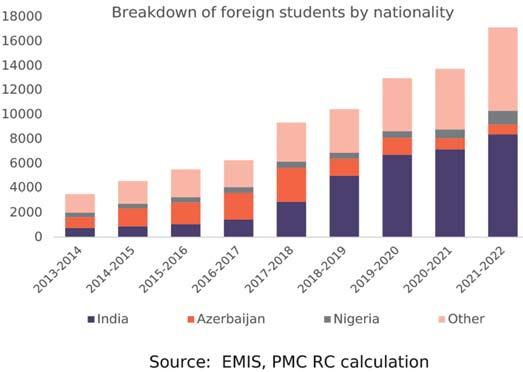
FOREIGN LANGUAGE PROGRAMS
With the growth in the number of foreign students in Georgia, the number of foreign-language educational programs has also increased in Georgian universities. For instance, from the 2013-2014 academic year to the 2021-2022 academic year, the number of foreign-language programs increased from 61 to 191. The majority of them (165) are in English, with 23 in Russian, 2 in French, and 1 in German. The growth in the number of programs is noticeable at every academic level. From the 2013-2014 academic year to the 2021-2022 academic year, the number of bachelors programs increased from 34 to 95, masters programs rose from 13 to 46, and doctoral programs soared from 6 to 17. Pertinently, one-step medical programs witnessed the highest growth, more than quadrupling from 8 to 33. It is also worth noting that over the analyzed period, the number of universities providing foreignlanguage programs tripled from 11 to 33.
In the academic year of 20212022, the distribution of foreign language programs in which foreign students are enrolled is as follows: medicine-related fi elds - 27%; business, management, and law - 26%; social and behavioral sciences, humanities and arts - 17%; engineering, architecture and construction - 12%, computer science - 9%; other fi elds - 9%. Moreover, the breakdown of foreign students across these programs is as follows: medicinerelated fi elds – 89%; business, management, and law - 5%; social and behavioral sciences, humanities and arts - 2%; architecture and construction - 2%, computer science -1%; and other fi elds - 1%. Thus, the distribution of students across fi elds is unequal.
AVERAGE TUITION FEE FOR FOREIGN LANGUAGE EDUCATIONAL PROGRAMS (IN WHICH FOREIGN STUDENTS ARE ENROLLED)
From the 2013-2014 academic year to the 2021-2022 academic year, tuition fees for foreign-language educational programs, in which foreign students were enrolled, nearly doubled, from GEL 4,300 to GEL 8,300. The annual growth rate over this period amounted to 9%. Despite the increase in tuition fees in GEL, these have not increased in USD. In fact, over the analyzed period this decreased from USD 2,600 to USD 2,500. Hence, the increase in tuition fees in GEL was strongly determined by the depreciation of the Georgian Lari.
In the 2021-2022 academic year, the highest average tuition fees are for medicine, healthcare, pharmacy and dentistry programs (GEL 11,521), followed by computing (GEL 8,960). Meanwhile, the lowest tuition fees are for social and behavioral sciences, humanities, and arts (GEL 4,660).
The total amount of tuition fees paid by foreign students and its share in the education sector’s GDP has been steadily increasing since the 2013-2014 academic year.
From the 2013-2014 academic year to the 2021-2022 academic year, the total amount of tuition fees paid by foreign students increased from GEL 14 million to GEL 180 million, with an average annual growth rate of 39%. However, the increase in the total amount of tuition fees has not been as signifi cant in USD as it has been in GEL. Over the analyzed period, the total amount of tuition fees paid increased from USD 8 million to USD 56 million, indicating an average annual growth rate of 29%.
As the number of total tuition fees paid increased over the analyzed period, its share in the education sector’s GDP also grew steadily. From the 2013-2014 academic year to the 2021-2022 academic year, this share increased from 1.1% to 8.6%. In terms of total GDP, over the analyzed period, the share increased from 0.05% to 0.36%.
Overall, foreign students’ interest in studying in Georgia has been rising rapidly in recent times. Due to this increased demand, Georgian universities have started to increase the number of educational programs in foreign languages accordingly. Along with the growing number of foreign students, their fi nancial contribution to Georgian higher education has also increased. However, the increased interest is becoming more homogenous as the vast majority of students are choosing medical programs and most of them are from India. An apparently emerging dependence on the medical fi eld and Indian students might create some challenges in the future. With this in mind, the Georgian higher education system should put more effort toward attracting students from different countries and increase interest, of foreign students, in other academic fi elds besides medicine.
